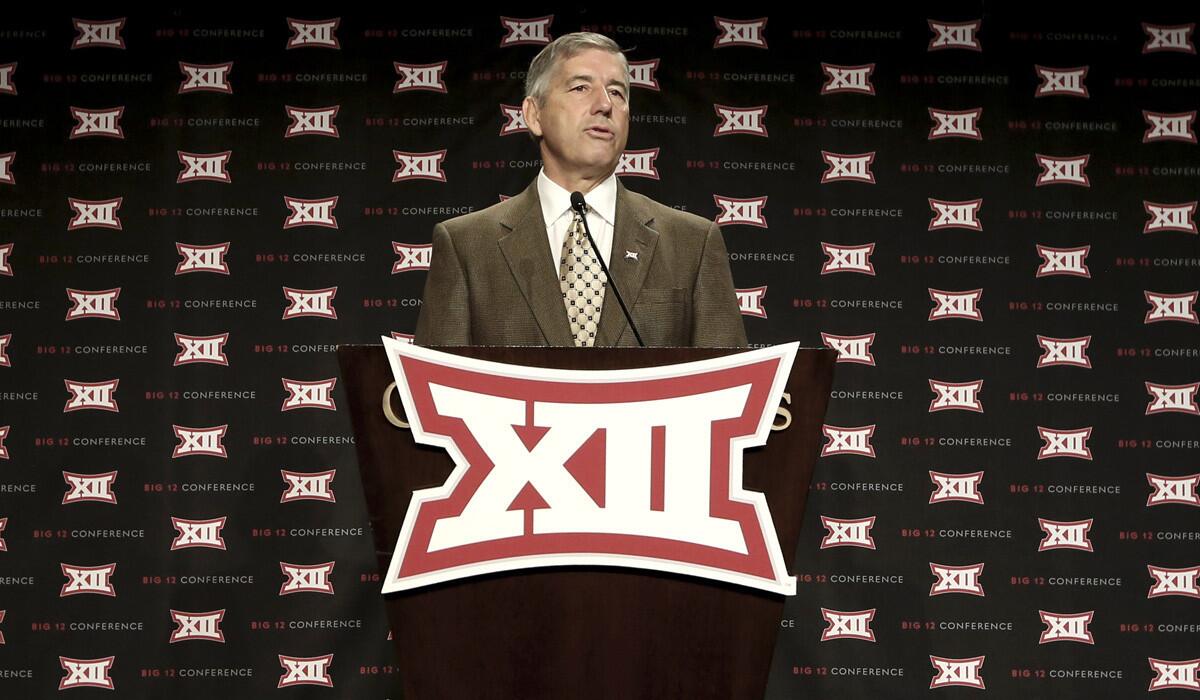NCAA approves more autonomy for ‘Power Five’ football conferences

Big 12 Conference Commissioner Bob Bowlsby has been a leading proponent of the five power football conferences getting more autonomy from the NCAA membership.
The NCAA board of directors, as expected, voted Thursday to grant the five wealthiest conferences in college football more freedom to pass legislation without approval of the full NCAA membership.
The shock would have been if the NCAA had not approved the legislation.
The vote, conducted at NCAA headquarters in Indianapolis, is subject to a 60-day veto period but is not expected to be overridden.
The 65 schools in the Pac-12, Southeastern, Big Ten, Big 12 and Atlantic Coast conferences had threatened to form their own division if not granted more autonomy within the NCAA.
The “Power Five” football leagues had grown frustrated in being overruled by the larger NCAA membership of 351 schools.
The richest leagues have garnered a disproportional amount of money, thanks to huge football television deals and other revenue streams, but lacked the voting power to use the funds as they pleased.
Immediately, Thursday’s NCAA vote will allow the Power Five to enact legislation to offer “full cost of attendance” benefits to student athletes.
Pac-12 Commissioner Larry Scott said the stipend would likely range between $2,000 and $5,000 per student at schools in his conference. The amount will vary as each school calculates full costs in accordance with federal guidelines.
Factors such as demographics will be considered. For instance, it costs more to live in Los Angeles than Pullman, Wash., so an athlete at UCLA might receive more than an athlete at Washington State.
“It is complicated,” Scott said recently about how the stipend would be calculated. “You have private vs. public [schools], I’m advocating that whatever it is, it is. And if it’s different on each campus, so what? The value of your tuition is different on each campus .… There are all kinds of competitive differences: the types of facilities you’ve got, the coach you’ve got, the city that you’re in, the value of your housing, the value of your scholarship. I think it’s got to go that way.”
Scott said at Pac-12 media day last month that many details still had to be worked out but that he expected “full cost” would be approved at January’s NCAA Convention in time for 2015-16 football season.
All 351 schools in Division 1 would be allowed to offer full cost of attendance. However, the 65 schools from the Power Five have the advantage of tapping football revenue to pay the stipend. The Pac-12, for example, just signed a 12-year, $3-billion TV deal with ESPN and Fox.
There are 128 schools that play Division 1 football, but only 65 from the leagues that reap disproportional benefits via huge revenue streams.
A 2011 proposal by SEC Commissioner Mike Slive for a $2,000-per-year stipend for athletes was rejected by the full NCAA.
As a result, Slive and other power commissioners threatened to form their own division, or even leave the NCAA, if they were not granted autonomy on certain issues.
The NCAA is in an increasingly defensive mode as it fights credibility issues and legal battles involving player unionization and licensing rights.
Big 12 Commissioner Bob Bowlsby, speaking Wednesday at an NCAA forum in New York, said the power leagues needed to be “a little less magnanimous about the 350 schools and spend a little time worrying about the most severe issues that are troubling our programs among the 65.”
More to Read
Go beyond the scoreboard
Get the latest on L.A.'s teams in the daily Sports Report newsletter.
You may occasionally receive promotional content from the Los Angeles Times.











